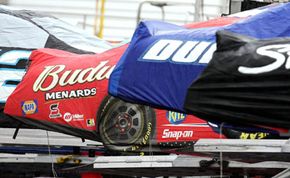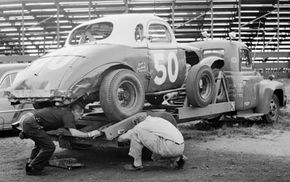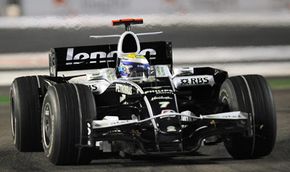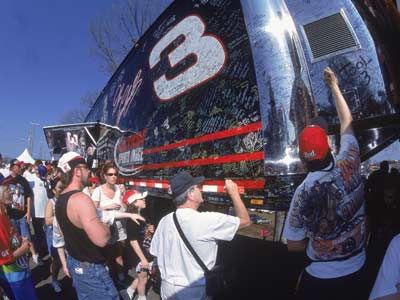Your first consideration in choosing a tow vehicle is to find one that has sufficient power to handle the trailer, the race car, and any additional equipment inside the trailer. If you've decided to build or purchase a relatively light, open trailer you'll need less power than if you purchase an enclosed trailer that contains not only your car but your tools, clothes and a personal residence. But even with an open trailer, you'll need at least a V6 engine and quite possibly a V8. However, you won't necessarily need a truck to do the job. An SUV will often be sufficient for towing purposes, and even a high-powered car may have enough pulling power to get you to the racetrack. (If price is a problem, consider buying a used vehicle instead of a new one.) The tow vehicle's suspension must also be strong enough to support the trailer's weight. And, though this may not be immediately obvious, the tow vehicle should weigh more than the fully loaded trailer. As a rule, the weight being towed shouldn't be greater than 75 percent of the weight of the tow vehicle. Although your final choice will depend on just how heavy a load you're towing, here are some vehicles that race cars owners have successfully used:
- Trucks: Honda Ridgeline, Ford F350
- SUVs: Chevrolet Suburban, Dodge Durango, GMC Yukon
- Cars: Dodge Magnum R/T, Ford Crown Victoria
Keep in mind that your towing plans may change in the future. For now you may have an open trailer that carries a single race car, but in the future you might want to upgrade to a closed trailer that carries two race cars. When that time comes, of course, you can choose to upgrade the tow vehicle as well, but you can save money by choosing a vehicle now that will handle your needs a couple of years from now. Choosing an overpowered tow vehicle is rarely a problem, but having an underpowered vehicle when you upgrade your trailer would be a problem indeed. So think ahead.
Once you've chosen a tow vehicle, you might consider adding some accessories to improve your towing experience. If your trailer has electric brakes, an essential add-on for the tow vehicle is a trailer brake controller. This device activates the trailer's brakes at the same time as the brakes on the tow vehicle. Trailer brake controllers come in two varieties: proportional controllers and time-delayed controllers. The first type activates the trailer's brakes in proportion with the brakes in the tow vehicle, while the second type activates the trailer's brakes at a preset rate. Generally speaking, proportional controllers are preferable, but the time-delayed controllers are less expensive, so the decision depends on how much money you have to invest. Remember, though, that the goal is to protect your investment in your race car, so consider getting the proportional kind.
Also consider getting a weight-distributing hitch. A normal hitch will put the trailer's entire tongue weight (the downward force on the hitch ball) on the tow vehicle's rear axle. This will lower the rear of the tow vehicle and lift its front end, reducing performance. A weight-distributing hitch, on the other hand, spreads the tongue weight across all of the tow vehicle's axles, keeping it level. If your trailer weighs more than half of what your tow vehicle weighs, this is a smart investment.
See the next page for more information about towing race cars.





